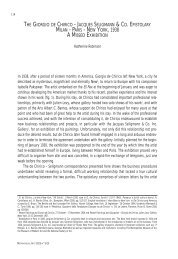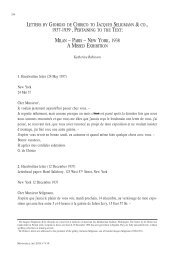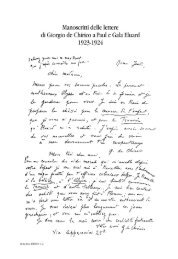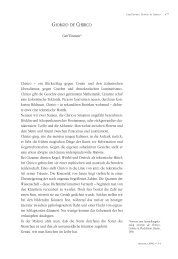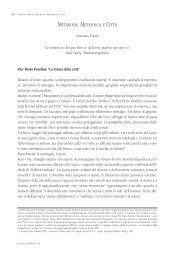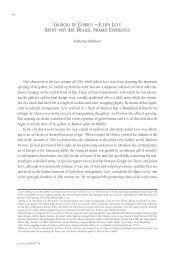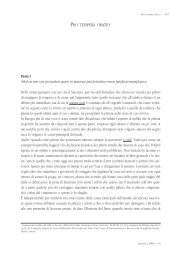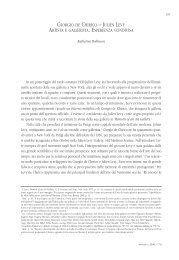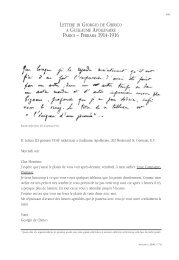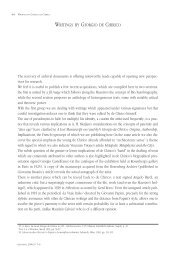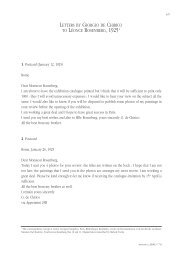Emplastic Oil - Fondazione Giorgio e Isa de Chirico
Emplastic Oil - Fondazione Giorgio e Isa de Chirico
Emplastic Oil - Fondazione Giorgio e Isa de Chirico
You also want an ePaper? Increase the reach of your titles
YUMPU automatically turns print PDFs into web optimized ePapers that Google loves.
174<br />
SALVATORE VACANTI: FROM MURAL PAINTING TO “EMPLASTIC OIL”<br />
Tradition to me means a painterly temperament united with craft, clairvoyance, a high poetic and<br />
moral sense of life and of the world, and a willingness to avoid all loopholes and to consistently better<br />
the quality of one’s painting. 70<br />
During this period the artist also toyed with the i<strong>de</strong>a of teaching his “craft” in public institutions.<br />
He addressed the minister Bottai on the matter and later attributed the negative response he received<br />
in his Memoirs as such:<br />
[…] Bottai was the protector of all illiterate people in the art world and a strong supporter of all imbecility<br />
and snobbery of the Parisian type. 71<br />
While <strong>de</strong> <strong>Chirico</strong> kept exhibiting regularly, the political situation in Italy took a downward turn<br />
and in September 1938 the so-called “Measures for the Defence of the Race” were issued. Uneasy<br />
due to <strong>Isa</strong>bella Pakszwer’s Jewish ancestry, the couple left Milan again for Paris. Here, the artist tirelessly<br />
resumed his technical research, in the midst of which he experienced a “third revelation”. After<br />
having un<strong>de</strong>rgone his first revelation in 1910 in Florence’s Piazza Santa Croce, <strong>de</strong> <strong>Chirico</strong> had had a<br />
“second revelation” in the 1920s in Rome’s Villa Borghese Museum, an event that reconciled him with<br />
Renaissance painting and inspired him to experiment with oil tempera. A third revelation, which<br />
occurred in the Louvre and instigated new and important research, is recalled in his Memoirs as such:<br />
One afternoon at the Louvre we were standing in front of a portrait by Velázquez and talking about<br />
the mysterious materials used by the Old Masters […]. <strong>Isa</strong>bella sud<strong>de</strong>nly said “This is not paint that<br />
has been dried, but beautifully tinted matter”. <strong>Isa</strong>bella’s words were a revelation to me […]. At the<br />
same time I met a restorer named Van<strong>de</strong>nberg who specialised in the restoration of Flemish paintings<br />
and who worked at the Louvre. He showed me in his studio a kind of whitish oily substance, a kind<br />
of poma<strong>de</strong> with which he diluted his colours […] Van<strong>de</strong>nberg, however, did not want to give me the<br />
formula for his oily substance […]. I un<strong>de</strong>rstood, however, that it was an emulsion of oily resinous<br />
substances, with gums, or with glue and water […]. I began to make emulsions of my own […]. This<br />
was the first step towards the conquest of great painting […]. Some of my paintings, which I painted<br />
with this new technique, were noticed and praised by various, particularly competent people, including<br />
the well-known painter and restorer Maroger […]. 72<br />
The inci<strong>de</strong>nt must have occurred sometime in the autumn of 1938. Thereafter, <strong>de</strong> <strong>Chirico</strong> began<br />
experimenting once again with oil-protein emulsions 73 as he had done earlier on with oil tempera.<br />
70<br />
G. <strong>de</strong> <strong>Chirico</strong>, Risposta al referendum, in “L’Ambrosiano”, Milan, 23 February 1938; now in “Metafisica” n. 3/4, Le Lettere, Florence, Pictor O, Rome<br />
2004, pp. 473-474. There were five questions, i<strong>de</strong>ntical for everyone: “1) What does Tradition mean to you 2) How do you consi<strong>de</strong>r the present state<br />
of European Contemporary Art 3) What were the consi<strong>de</strong>rations that most urged you to leave the “Avant-gar<strong>de</strong>” 4) What does the nineteenth century<br />
mean to you 5) What is the value of young art Who do you consi<strong>de</strong>r to be the best young artist”<br />
71<br />
G. <strong>de</strong> <strong>Chirico</strong>, The Memoirs…, cit., p. 140.<br />
72<br />
Ibid…, pp. 148-149.<br />
73<br />
The mixture of protein substances (egg, casein, animal glues) or polysacchari<strong>de</strong>s (vegetable gums) with oils forms an emulsion. This is a heterogeneous<br />
system in which an unmixable liquid is dispersed in the form of very tiny drops into another liquid called the disperser. The emulsion is there-<br />
METAPHYSICAL ART 2010|N° 9/10



